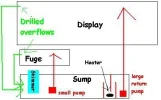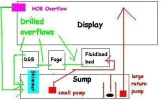Ok I have gathered my tanks....I have a 20 gallon and a 10 gallon......Im using the 10 gallon as my fuge and the 20 as my sump.....have a question..... what is a DSB and a fluidized bed?????
DSB = Deep Sand Bed
Here's how it works:
Nitrogen Cycle
In our tanks, we have oxygen and bacteria that live on that oxygen. These are AEROBIC bacteria. They are like almost every other living thing on the planet and require oxygen to survive. These AEROBIC bacteria live on the outer surface of our live rock. They live on the walls of the tank. They live on the top 1" layer of sand.
Aerobic bacteria eat the broken down fish waste. They break down ammonia into nitrite. And they break down nitrite into nitrate. But thats as far as aerobic bacteria can take the nitrogen cycle. You're stuck with nitrates. Nitrates are bad in high concentrations. They damage internal organs of your fish and poison your corals.
So, what to do with the nitrates? How do you get rid of them?
There is manual removal - i.e. water changes.
There is nutrient export - i.e. macro algae that you grow in the sump/refugium. These macro algae will absorb the nitrates and use it for food to grow. You simply cut out 1/2 of the macro algae monthly to toss it in the trash. You cut it out - you just exported the nitrates. Thats nutrient export.
And there is the DSB.
A DSB has to be AT LEAST 4" deep. I personally think it works better if you go 6" deep. Some people even build remote DSB in a 5g bucket and fill it almost to the top with sand. So there is no set rule for maximum depth. Look at our oceans. How deep is the sand bed?
How does the DSB work?
Okay, we talked about the AEROBIC bacteria that live where there is plenty of oxygen. The other type of bacteria are called ANAEROBIC.
ANAEROBIC CANNOT live in oxygen. It kills them. ANAEROBIC bacteria live way down deep in the lower regions of the sand bed where there is no oxygen. All the oxygen in the water gets used up in the first 1" or 2" of the sand bed. Your aerobic bacteria, pods, worms and other micro fauna use all the oxygen in the upper layers of the sand bed. Thats how they stay alive. So by the time the water makes it's way to the bottom of the sand bed, there is no more oxygen left. This is where your ANAEROBIC bacteria colony will grow.
ANAEROBIC bacteria LOVE to eat nitrates. Remember, our AEROBIC bacteria can only take the nitrogen cycle to nitrates. They stop working there because they cannot process the nitrates. So this is where your ANAEROBIC bacteria kick in. They do process the nitrates as food and they break it down into nitrogen gas.
Nitrogen gas is the final step. The nitrogen cycle is complete now. Nitrogen gas is harmless to our fish and inverts. It's harmless to people. After the anaerobic bacteria break the nitrates down into nitrogen gas - it simply gets released from the sand bed in the form of bubbles. Those bubbles rise to the surface of the water where they pop and "off gas" into the surrounding air. As long as your surface water is being turned over and agitated sufficiently, you're tank will have no problems off gassing the harmless nitrogen gas into your house.
You should NEVER stir a DSB or use a gravel vacuum on a DSB!!!!!!!!!
Why? Because the sand bed has 2 different regions.
There is the upper region, where your AEROBIC bacteria grow.
There is the lower region where your ANAEROBIC bacteria grow.
Remember, AEROBIC bacteria MUST have oxygen to grow. Without oxygen they will die. ANAEROBIC bacteria CANNOT live where there is oxygen. If exposed to oxygen they will die.
What happens when you shove a gravel vac into a sand bed? It all gets stirred up and churned over and over.
Now the top layer of sand is going to end up somewhere else - probably in a place where there is no oxygen. Your aerobic bacteria are going to suffocate and die. When they die, they will rot. Rotting dead stuff produces nitrates.
And the bottom layer of sand is going to end up on top, or closer to the surface, where there is oxygen. What happens to ANAEROBIC bacteria when they are exposed to oxygen? They die. What happens when bacteria die? They rot and produce nitrates.
Nitrates are bad for your tank. And a sudden spike in nitrates from a gazzillion billion dead bacteria will produce a BIG nitrate spike.
You just crashed your tank.
So, why is it okay to have a sand sifting goby in your tank if you have a DSB?
Because they only sift
small areas of the DSB at one time. When they dig deep down and burrow a hole under a rock, they are stirring the sand bed and they are mixing it up. Bacteria are dieing. But it is such a small portion of your sand bed, that it will not cause a massive nitrate spike and subsequent crash.
If you introduced 25 sand sifting gobys to an established DSB, I'm betting they would stir and churn it enough to cause the nitrate spike and crash. But just one little goby can't dig down deep enough and he can't dig in a big enough space to cause the huge spike.
I actually think it's almost a requirement that you keep a sand sifting goby with a DSB. There is some benefit to having the sand bed slowly turned over during a long period of time. Undisturbed DSB will compact over time and calcify into a big lump. Then it stops working because it's no longer permeable to the water. The goby works his way around the tank every couple months and slowly sifts the sand. By doing so, it keeps the bed loose and permeable to the water that must flow through it in order to function correctly.
Anymore questions, please ask. :Cheers:


